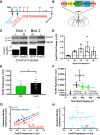Beyond Critical Period Learning: Striatal FoxP2 Affects the Active Maintenance of Learned Vocalizations in Adulthood
- PMID: 31001575
- PMCID: PMC6469881
- DOI: 10.1523/ENEURO.0071-19.2019
Beyond Critical Period Learning: Striatal FoxP2 Affects the Active Maintenance of Learned Vocalizations in Adulthood
Abstract
In humans, mutations in the transcription factor forkhead box P2 (FOXP2) result in language disorders associated with altered striatal structure. Like speech, birdsong is learned through social interactions during maturational critical periods, and it relies on auditory feedback during initial learning and on-going maintenance. Hearing loss causes learned vocalizations to deteriorate in adult humans and songbirds. In the adult songbird brain, most FoxP2-enriched regions (e.g., cortex, thalamus) show a static expression level, but in the striatal song control nucleus, area X, FoxP2 is regulated by singing and social context: when juveniles and adults sing alone, its levels drop, and songs are more variable. When males sing to females, FoxP2 levels remain high, and songs are relatively stable: this "on-line" regulation implicates FoxP2 in ongoing vocal processes, but its role in the auditory-based maintenance of learned vocalization has not been examined. To test this, we overexpressed FoxP2 in both hearing and deafened adult zebra finches and assessed effects on song sung alone versus songs directed to females. In intact birds singing alone, no changes were detected between songs of males expressing FoxP2 or a GFP construct in area X, consistent with the marked stability of mature song in this species. In contrast, songs of males overexpressing FoxP2 became more variable and were less preferable to females, unlike responses to songs of GFP-expressing control males. In deafened birds, song deteriorated more rapidly following FoxP2 overexpression relative to GFP controls. Together, these experiments suggest that behavior-driven FoxP2 expression and auditory feedback interact to precisely maintain learned vocalizations.
Keywords: auditory feedback; basal ganglia; birdsong; sensorimotor; speech.
Figures





Similar articles
-
Striatal FoxP2 is actively regulated during songbird sensorimotor learning.PLoS One. 2010 Jan 6;5(1):e8548. doi: 10.1371/journal.pone.0008548. PLoS One. 2010. PMID: 20062527 Free PMC article.
-
Expression analysis of the speech-related genes FoxP1 and FoxP2 and their relation to singing behavior in two songbird species.J Exp Biol. 2013 Oct 1;216(Pt 19):3682-92. doi: 10.1242/jeb.085886. J Exp Biol. 2013. PMID: 24006346 Free PMC article.
-
CHIRP-Seq: FOXP2 transcriptional targets in zebra finch brain include numerous speech and language-related genes.BMC Neurosci. 2025 Apr 25;26(1):29. doi: 10.1186/s12868-025-00948-6. BMC Neurosci. 2025. PMID: 40281419 Free PMC article.
-
Auditory experience and adult song plasticity.Ann N Y Acad Sci. 2004 Jun;1016:208-21. doi: 10.1196/annals.1298.017. Ann N Y Acad Sci. 2004. PMID: 15313777 Review.
-
Tutor auditory memory for guiding sensorimotor learning in birdsong.Front Neural Circuits. 2024 Jul 1;18:1431119. doi: 10.3389/fncir.2024.1431119. eCollection 2024. Front Neural Circuits. 2024. PMID: 39011279 Free PMC article. Review.
Cited by
-
FOXP transcription factors in vertebrate brain development, function, and disorders.Wiley Interdiscip Rev Dev Biol. 2020 Sep;9(5):e375. doi: 10.1002/wdev.375. Epub 2020 Jan 30. Wiley Interdiscip Rev Dev Biol. 2020. PMID: 31999079 Free PMC article. Review.
-
Identification of FoxP circuits involved in locomotion and object fixation in Drosophila.Open Biol. 2020 Dec;10(12):200295. doi: 10.1098/rsob.200295. Epub 2020 Dec 16. Open Biol. 2020. PMID: 33321059 Free PMC article.
-
Activity of forkhead box P2-positive neurons is associated with tadpole begging behaviour.Biol Lett. 2024 Sep;20(9):20240395. doi: 10.1098/rsbl.2024.0395. Epub 2024 Sep 25. Biol Lett. 2024. PMID: 39317327
-
Genomic loss of GPR108 disrupts AAV transduction in birds.bioRxiv [Preprint]. 2024 May 17:2024.05.16.589954. doi: 10.1101/2024.05.16.589954. bioRxiv. 2024. PMID: 38798475 Free PMC article. Preprint.
-
Activity of FoxP2-positive neurons is associated with tadpole begging behavior.bioRxiv [Preprint]. 2024 Aug 29:2023.05.26.542531. doi: 10.1101/2023.05.26.542531. bioRxiv. 2024. Update in: Biol Lett. 2024 Sep;20(9):20240395. doi: 10.1098/rsbl.2024.0395. PMID: 37292748 Free PMC article. Updated. Preprint.
References
-
- Bottjer SW, Miesner EA, Arnold AP (1984) Forebrain lesions disrupt development but not maintenance of song in passerine birds. Science 224:901–903. - PubMed
